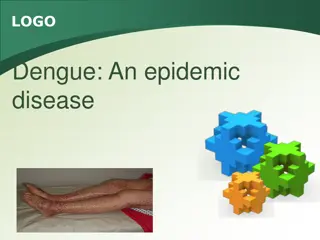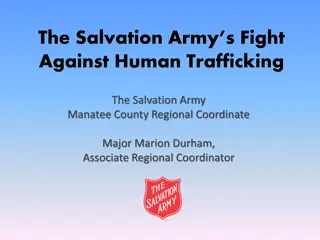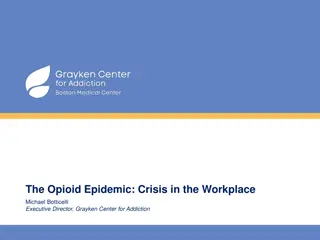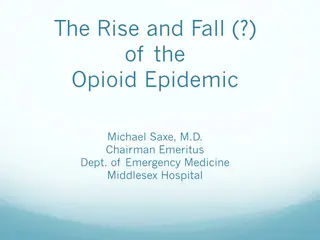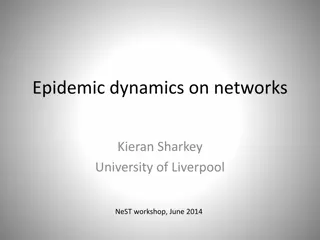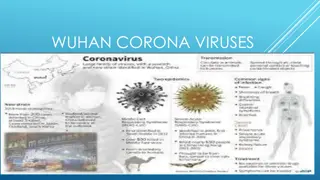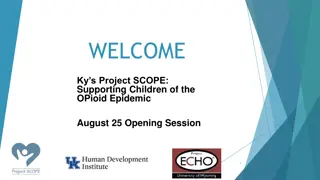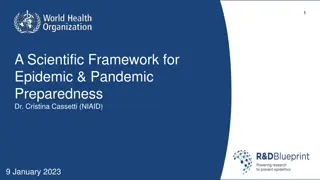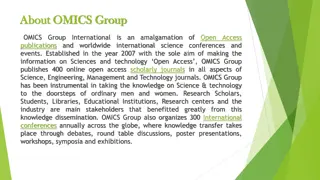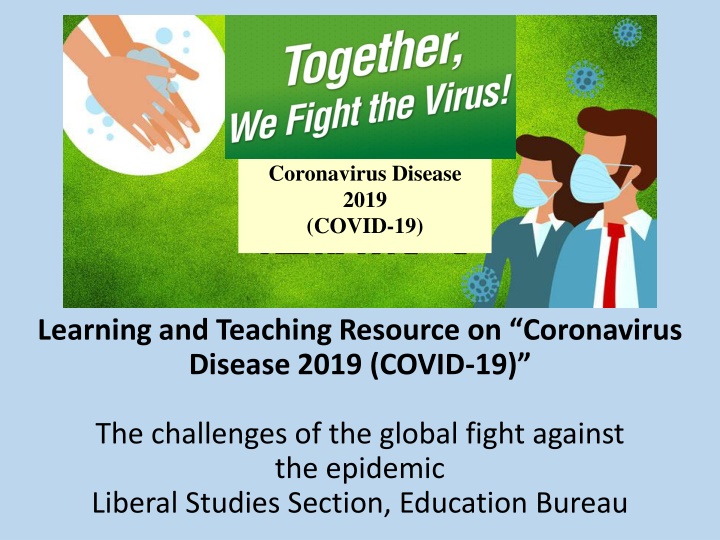
Global Fight Against Epidemic - Learning Resource
This resource focuses on the challenges of the global fight against epidemics, specifically exploring the relationship between globalization and the spread of infectious diseases. It emphasizes the importance of international cooperation and public health safety in addressing global health issues such as COVID-19.
Download Presentation

Please find below an Image/Link to download the presentation.
The content on the website is provided AS IS for your information and personal use only. It may not be sold, licensed, or shared on other websites without obtaining consent from the author. If you encounter any issues during the download, it is possible that the publisher has removed the file from their server.
You are allowed to download the files provided on this website for personal or commercial use, subject to the condition that they are used lawfully. All files are the property of their respective owners.
The content on the website is provided AS IS for your information and personal use only. It may not be sold, licensed, or shared on other websites without obtaining consent from the author.
E N D
Presentation Transcript
Coronavirus Disease 2019 (COVID-19) Learning and Teaching Resource on Coronavirus Disease 2019 (COVID-19) The challenges of the global fight against the epidemic Liberal Studies Section, Education Bureau
Introduction of the Learning and Teaching Resource Key stage / grade Topic Relevant curriculum content / learning focus Teaching resources (PPT) Senior secondary The challenges of the global fight against the epidemic Liberal Studies: Module 4 Globalization & Module 5 Public Health PPT
Introduction of the Learning and Teaching Resource Through discussion of the issue, students could: understand the relationship between globalization and the spread of epidemic, and the impact of the spread of infectious diseases on public health. understand the importance of international cooperation on maintaining public health safety. Learning objectives Related concepts Globalization, population mobility, global governance, international cooperation, infectious diseases Read the information and watch the video clip, and ask students to discuss and answer the questions. Guide students to understand the impact of infectious diseases, and how to maintain public health safety through international cooperation. Website of Centre for Health Protection (CHP) Website of World Health Organization (WHO) Liberal Studies Curriculum Resources Booklet Series: Globalization & Liberal Studies Curriculum Resources Booklet Series: Public Health Learning and teaching strategies References
Introduction of the Learning and Teaching Resource In view of the ongoing development of COVID-19, teachers should remind students of staying alert to the latest development of the disease, and browsing the website of CHP for the latest information. The development of globalization has enhanced the interdependence among countries and resulted in various global, cross-border challenges. One example is globalization of tourism, which increases the risk of virus spread around the world. Teachers should remind students that in face of the spread of epidemics or other global cross-border issues, multilateral joint actions of various countries and more global public policies and plans built on collaboration are required to respond effectively and appropriately. During the lesson, teachers should promote relevant positive values and behaviours, and encourage students to put them into practice in daily life. Remarks
Preparation for lesson Watch the following video clip, to learn about the basic information of Coronavirus Disease 2019 (COVID-19) Response from Dr. Maria Van Kerkhove of WHO for the Coronavirus Disease 2019 (COVID-19) Adapted from the website of World Health Organization Length of the video clip: 1 minute 21 seconds http://terrance.who.int/mediacentre/videos/coronavirus/WHO-PROD_Coronavirus_QA_14JAN2020_en_st_ch.mp4
Coronavirus Disease 2019 (COVID-19) Grasp the background knowledge 1. What is Coronavirus Disease 2019 (COVID-19)? What is its pathogen? 2. What are the symptoms of COVID-19? 3. What is the mode of transmission of COVID-19? 4. Is there a vaccine against the disease?
Coronavirus Disease 2019 (COVID-19) Grasp the background knowledge SuggestedAnswers 1. Coronavirus Disease 2019 (COVID-19) refers to the cluster of viral pneumonia cases occurring in Wuhan, Hubei Province, since December 2019. According to investigation by the Mainland health authorities, a novel coronavirus is found to be the causative agent. 2. According to information provided by the Mainland health authorities, symptoms of the cases include fever, malaise, dry cough and shortness of breath. Some cases were in serious condition. People of older age or having underlying disease are at a higher risk of deterioration into serious condition. 3. The main mode of transmission of the Coronavirus Disease 2019 (COVID-19) is through respiratory droplets, the virus can also be transmitted through contact. 4. There is currently no specific treatment for Coronavirus Disease 2019 (COVID-19) . However, many of the symptoms can be treated and therefore treatment is based on the patient s clinical condition. There is no vaccine currently available for the new diseases, and it may take years to develop a new one. Source Adapted from the website of Centre for Health Protection https://www.chp.gov.hk/tc/features/102624.html
Read the following information Source A Concepts related to this topic Globalization: It is featured by the continuous decrease in the restriction of geographical barrier on various political, cultural, economic and social activities, which allows ordinary people to take part in more cross-regional activities. It allows personal life, social relations and even social systems, which were previously limited to the local region or country, to extend across regions and worldwide. Global governance: It is a process of political coordinations at various levels, aiming at dealing with global issues such as international conflicts, climate change and epidemic spread, in order to maintain world order. International governmental organizations are one of the enforcers of global governance. For example, the World Health Organization (WHO) sets global standards of public health and appeals to each country to comply with such. At the same time, it is the main organisation that monitors infectious diseases around the globe. Infectious diseases: It refers to diseases caused by the transmission of pathogens to human beings. In severe cases, they may lead to death. Infectious diseases can spread through various means. Some spread through direct human contact, whereas others are contracted through water, the air, droplets, food, body fluid, excreta or any other medium (such as insects). Sources Globalization , Liberal Studies Curriculum Resources Booklet Series: Globalization , P. 18 Global governance , Liberal Studies Curriculum Resources Booklet Series: Globalization , P. 32 Infectious diseases , Liberal Studies Curriculum Resources Booklet Series: Public Health , P. 20
Source B For information about countries / areas with reported cases of Coronavirus Disease 2019 (COVID-19) Refer to the relevant information of the Centre for Health Protection: https://www.coronavirus.gov.hk/
Source C The World Health Organization (WHO) is an organisation under the United Nations taking charge of health issues and aims to support member states to reduce the spread of diseases and enhance medical care. Through its support in evaluating, planning and implementing national policies on infection control, WHO actualises its ultimate missions of WHO are to help member states improve medical care quality, and the environmental and personal safety for patients, medical staff and individuals working in medical sector, in a cost-effective manner. Source: Official website of the World Health Organization http://www.who.int/zh/
Source D The International Health Regulations (2005) provide a framework for WHO epidemic alert and rapid response activities so as to respond the international outbreaks and other emergencies involving public health risks. Dr Tedros Adhanom Ghebreyesus, Director- General of the World Health Organization, listed the Coronavirus Disease 2019 (COVID-19) outbreak as Public Health Emergency of International Concern (PHEIC) under the Ordinance on January 30, 2020. A PHEIC is defined as, an extraordinary event which is determined to constitute a public health risk to other States through the international spread of disease and to potentially require a coordinated international response . This definition implies a situation that is: serious, sudden, unusual or unexpected, carries implications for public health beyond the affected State s national border; and may require immediate international action. Sources: 1. Statement on the second meeting of the International Health Regulations (2005) Emergency Committee regarding the outbreak of novel coronavirus (2019-nCoV) 2. Frequently asked questions on IHR Emergency Committee
Suggested questions for discussion 1. With reference to the concept of "Globalization" in Source A, do you think the global spread of "Coronavirus Disease 2019 (COVID- 19)" shown in Source B is related to the development of globalization? SuggestedAnswers Globalization has broken down the geographical barriers between communities and increased the population mobility. Residents of various countries thus often engage in cross-border activities for tourism, business trips, trade or other exchange activities. As a result, some infectious diseases, which are originally regional in nature only, spread into one place due to international population movement and can be spread to all parts of the world within a short period of time. Globalization promotes frequent transportation, and the well-developed transportation shortens the distance between countries. This results in large-scale rapid spread of infectious diseases within a short period of time. With the development of the aviation industry, the number of passengers around the world has increased, accelerating the global spread of epidemics. If the health measures of each country are not strict enough or under strict surveillance, the epidemic can easily spread from the border and to other areas rapidly.
Suggested questions for discussion 2. With reference to the source, why is the Coronavirus Disease 2019 (COVID- 19) outbreak considered as a Public Health Emergency of International Concern (PHEIC) ? How is the concept of global governance reflected in the case where the World Health Organization helped combat the spread of the epidemic? SuggestedAnswers Since the outbreak of the Coronavirus Disease 2019 (COVID-19) began to spread in China in January 2020, the number of confirmed cases and deaths in China and other countries or regions around the world has been increasing, which is in line with the criteria of Public Health Emergency of International Concern (PHEIC) and an extraordinary event which is determined to constitute a public health risk to other States through the international spread of disease and to potentially require a coordinated international response . Therefore, the World Health Organization Emergency Committee held a meeting on 30 January 2020 to announce that the Coronavirus Disease 2019 (COVID-19) epidemic constitutes a Public Health Emergency of International Concern (PHEIC) .
Suggested Answers (To be continued) The development of globalization has led to many global, cross-border issues which have a significant impact on the world. Dealing with and preventing the spread of infectious diseases in the world is one of them. Since the spread of infectious diseases in many countries around the world cannot be solved by individual countries alone, it is necessary to rely on international organisations to coordinate and plan global public health matters. As a result, WHO takes on the role of coordinating countries, such as assessing the risk of epidemic spread and issuing a unified response. In view of the global spread of the Coronavirus Disease 2019 , WHO has classified it as a public health emergency of international concern in response to the outbreak, carried out surveillance work on the outbreak and recommended measures to be taken by the affected and other State parties. WHO s actions demonstrate how an international organisation can respond to a widely concerned and significant global issue and put forward strategies and recommendations to the international community, reflecting the concept of global governance.
Brief summary ---The development of globalization has enhanced the interdependence among countries and resulted in various global, cross-border challenges. One example is the globalization of tourism, which increases the risk of virus spreading to countries. ---In face of the spread of epidemics or other global cross-border issues, such as climate change, international financial crisis, cross-border crimes and other global issues, multilateral joint actions of all countries and more global public policies and plans built on collaboration are required to respond effectively and appropriately. ---To prevent the large-scale spread of virus, some countries affected by the epidemic are now implementing emergency measures, such as immigration controls, which are designed to meet short-term emergency needs and should not be regarded as acts of discrimination or exclusion.


